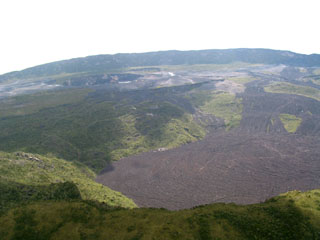Report on Nyamulagira (DR Congo) — 17 May-23 May 2023
Smithsonian Institution / US Geological Survey
Weekly Volcanic Activity Report, 17 May-23 May 2023
Managing Editor: Sally Sennert.
Please cite this report as:
Global Volcanism Program, 2023. Report on Nyamulagira (DR Congo) (Sennert, S, ed.). Weekly Volcanic Activity Report, 17 May-23 May 2023. Smithsonian Institution and US Geological Survey.
Nyamulagira
DR Congo
1.408°S, 29.2°E; summit elev. 3058 m
All times are local (unless otherwise noted)
The Observatoire Volcanologique de Goma (OVG) reported that lava continued to erupt from vents in Nyamulagira’s summit crater during 17-23 May. Lava flows began moving into the N and NW parts of the crater beginning on 9 May, towards the low point of the crater rim. Intense incandescence from the summit was visible from Goma (27 km S) during the evenings of 17 and 19 May. Satellite images showed a notable sulfur dioxide plume drifting NW and W during 19-20 May. Drone footage acquired on 20 May captured images of narrow lava flows traveling about 100 m down the W flank. Intense incandescence emanating from the summit was again visible from Goma at around 1830. Data from the Rumangabo seismic station indicated a downward trend in activity during 17-20 May and a significant decrease during 20-21 May. Though weather clouds were dense over the summit, hot lava on the NW flank was visible in a 22 May Sentinel-2 infrared (SWIR) image.
Geological Summary. Africa's most active volcano, Nyamulagira (also known as Nyamuragira), is a massive high-potassium basaltic shield about 25 km N of Lake Kivu and 13 km NNW of the steep-sided Nyiragongo volcano. The summit is truncated by a small 2 x 2.3 km caldera that has walls up to about 100 m high. Documented eruptions have occurred within the summit caldera, as well as from the numerous flank fissures and cinder cones. A lava lake in the summit crater, active since at least 1921, drained in 1938, at the time of a major flank eruption. Recent lava flows extend down the flanks more than 30 km from the summit as far as Lake Kivu; extensive lava flows from this volcano have covered 1,500 km2 of the western branch of the East African Rift.
Sources: Observatoire Volcanologique de Goma (OVG), Sentinel Hub

